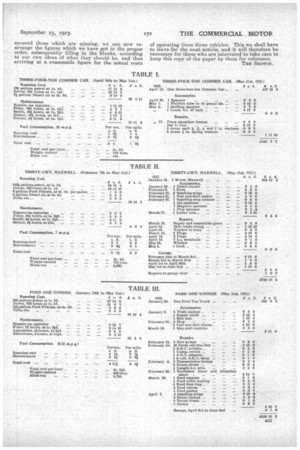THE HAULIERS' INQUIRE WITHIN.
Page 24

Page 25

If you've noticed an error in this article please click here to report it so we can fix it.
The Records of a Haulier's Operating Costs in Respect of Three Different Vehicles are Submitted to Us for Criticism, and are Here Criticised.
THE FIGURES which accompany this article have been sent to me with the request that I should criticise them. They are what might be called the balance sheets for three vehicles—'a Ford tanner, a 30-cwt. Maxwell and a 3-4-ton Commer Car. The inquirer does not specify the lines which my criticism should follow ; he does not say, for example, whether it is the actual expenditure per mile or per ton which I should investigate and report upon, and he does not tell me if it is his method of compiling and collating the costs or his book-keeping which he wants me to discuss.
Moreover, he does not state whether he himself regards the costs, as they stand, as being complete or not. It is clear, therefore, that I have an entirely free hand, and can say what I like, which is just exactly as it should be in an example for discussion on this page.
The first thing to which I would like to draw the attention of readers generally is the short time which these vehicles have been in use by this particulal owner; they are all, I believe second-hand machines. The dates which appear at the top right-hand corners of each schedule of figures show that the Ford has only been running for 18 weeks (actually, 955 hrs.), and the mileage is but 2,795. The Maxwell has been on the road for 16 weeks (actually, 820 hrs.), the milei age being 2,399. The Commer Car has only been in use for six weeks (actually, 292 hrs.), with a -mileage of 444: This must be borne in mind throughout the article, since it has a bearing on the cost of running: It is not safe to rely on these figures if a basis for estimate of operating costs be desired. We will first examine the figures to see if they are, according to our notions, complete ; that is to say, whether there are any items missing. We can best do this by comparison with our own schedules of operating costs, and ascertaining if all the items there
B40
shown are included here. The advantage of compd.. ing all costs according to a known formula will here be apparent. I will for the moment ignore the obvious faults of the costings, in that the running costs, standing charges, etcetera, are all mixed up and confused. Our items of expenditure in connection with a commercial vehicle are enumerated under the following heads :—Fuel, lubricants, tyres, maintenance and depreciation. The foregoing are all "running costs," since they vary directly, or nearly so, with the actual mileage which the vehicle covers. Then there are licences, wages, rent and rates (garage rent), insurance and interest on first cost.
• Looking through the figures of costs which we have before us, we find that there is no mention of tyres or of depreciation. There is nothing set down for licences, for insurance, or for interest on first cost. These are all serious omissions. There are some items which would not appear to come under any of these heads, and I will dismiss those, as I may, in a few words. " Accessories " is one. These, to judge by the list of them, are things which were bought at or about the same time as the vehicles were purchased. Their cost may very well be set down as part of the purchase price ofthe complete machines. On renewal, of course, they will be charged to maintenance. Then there is a. curious item "tolls." This is clearly not a fair charge against the vehicle, although it is part of the cost of transport. It should go down in the ledger as an incidental item of that cost, but not he debited to the actual operating cost of the vehicles. If we admit a charge of that kind, we shall shortly be expected to accept, say, in the case of a machine used for conveying milk, a charge for repairs' to milkcans, for that is just as much a charge against the transport of the milk, and just as little a charge against the cost of running the lorry, as is this item " tolls."
Having dismissed the superfluous items and die
covered those which are missing, we can now rearrange the figures which we have got in the proper order, subsequently filling in the blanks, according to our own ideas of what they should be, and thus arriving at a reasonable figure for the actual costs of operating these three V.ehicles. This we shall have to leave for the next articlet and it will therefore be necessary for those who are interested to take care to keep this copy of the paper by them for reference. Tux SKOTCH.






























